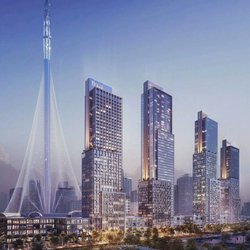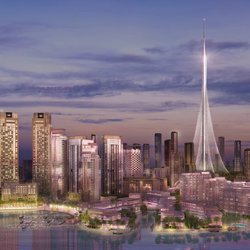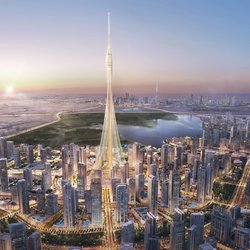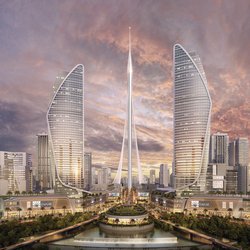Santiago Calatrava, a leading Spanish architect, structural engineer and sculptor who owns works such as the famous Malmو Swirl Tower in Sweden, the Menjovik Communication Tower in Barcelona and the Tomorrow Museum in Rio de Janeiro, now runs ambitious projects in Dubai such as the main hall of the Archipelago. This tower, designed by him inspired by irises, depicts a minaret that is a distinctive symbol of Islamic culture.
This building will be connected to the ground with strong cables and inspired by the delicate ribs of lily leaves. The cable matrix strengthens its structure and firmly transfers its load to the ground with technical precision using materials in accordance with the most modern engineering calculations.
Euronews interviewed the famous architect, the full text of which you can read below.






Euronews: Could you say what motivated you to enter the architectural profession?
Santiago Calatrava: Yes, I wanted to go to the University of the Arts after high school, and I remember visiting the Notre Dame de Paris. I remember it was about 11 o’clock in the afternoon and the light was coming in through the big latticed window of the church and it caught my eye and it was there that I realized what art architecture is. In fact, I studied architecture at the university as an art, but I also studied civil engineering because I wanted to learn more about materials, namely architectural materials, construction rules, evaluation and calculation, and all the mathematical aspects of the construction process. But in the end, the fact that architecture itself is an art motivated me to get into it.
Euronews: Your style is said to be neo-futurism or modernism. What do you say yourself?
Calatrava: The truth is that I do not know if I have a certain style or not, but if I have, it is the style of this period, of course I always think later, how to work better, how to make life better, how to build bolder buildings or Make it more beautiful or more appropriate for people, and this kind of thinking makes me think of my ideas more in the future, because I believe that the future will be better than today, or at least I hope it will be.
Euronews: Born in Valencia, Spain, what impact has your hometown had on your work style over the years?
Calatrava: The city where I grew up was a good place, because on one side it reached the Mediterranean. Valencia is a city that is open to the world, it has always been very welcoming, and it has many amazing buildings.
Euronews: Where is the most interesting architectural work for you?
Calatrava: I have been fascinated by every project and its innovation from the beginning. I design a lot. I draw a lot of sketches and I have people around me who take these designs and turn them into projects and then build real buildings from them. Therefore, architecture is a profession in which many skilled people should be around you.
Euronews: They say you are an architectural star, but your team is as great as you are.
Calatrava: I think it determines the abilities of people to which branch of architecture they tend. I always say that architecture is a modest profession, not an extroverted one. For each project, you have to work in the office for days, weeks, and sometimes years in private.
Euronews: We are in Dubai. Why has it become a city for architecture?
Calatrava: I remember very well how motivated I was 20 to 25 and even 30 years ago. Well, you look at your energy, your dreams and your hopes, and then there are places like Dubai where you can make those dreams come true, these places are full of passion and energy. Dubai is one of the cities that is 100% the symbol of our time, because it is almost 100% built in our time, which is almost the same as our generation.
Euronews: You are currently building the Dubai Creek Tower, which will be the tallest tower in the world when completed. Where did you get the idea to design this tower?
Calatrava: The idea for the Dubai Tower Cricket comes from the image of a flower with a long stem, like a tulip. Why flowers? Because I thought it was a very beautiful thing, for a building that at the same time has to be very simple and accommodate everything, and everyone can see its beauty when they see it.
Euronews: The famous Twisting Tower of Malmو in Sweden, and the Menjovik Communication Tower in Barcelona are some of your highlights. You were also the architect of the main hall of Expo 2020 Dubai. What inspired you to do this?
Calatrava: I think I tried to include in my work the symbol of what is the cultural essence here. I had in mind a picture of a falcon with open wings and the design of the main hall came from the heart.
Euronews: How does modern architecture push boundaries?
Calatrava: Today, materials such as carbon fiber can change our understanding of architecture because it can be given new shapes and some boundaries can be broken. There are other things as well, such as new energy technologies. Our understanding of energy is very different from 30 years ago, and today we are very concerned about reliability.
Euronews: The Museum of Tomorrow that you built in Rio de Janeiro is considered one of the best examples of sustainable architecture. What is the importance of sustainable architecture?
Calatrava: We have to take care of the land. Because it is the only place we have. Isn’t it? And the point is to at least try to pass this land on to the next generation as it came to us.
Euronews: How do you see your future?
Calatrava: You know, I honestly promised myself I would work for the rest of my life. Because I love work and it brings me a lot of satisfaction. Work keeps me passionate and hopeful. I also love the people around me, the people I work with and if I can I will work until the last day of my life.
Search
Recent Posts
Archives
Categories
Recent Posts
- Santiago Calatrava August 7, 2021
- Heydar Aliyev Cultural Center July 21, 2021
- Visual Academy Museum (Los Angeles) July 20, 2021
- What is a GRC? July 9, 2021
Calendar
| S | S | M | T | W | T | F |
|---|---|---|---|---|---|---|
| 1 | 2 | 3 | 4 | 5 | ||
| 6 | 7 | 8 | 9 | 10 | 11 | 12 |
| 13 | 14 | 15 | 16 | 17 | 18 | 19 |
| 20 | 21 | 22 | 23 | 24 | 25 | 26 |
| 27 | 28 | 29 | 30 | |||
